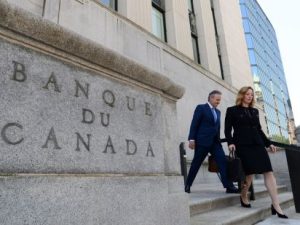The Canadian economy is experiencing a significant and rapid contraction. The shock is a global one, affecting all countries, but commodity-producing countries like Canada are being hit twice. Beyond the impact of the necessary public health measures to contain the virus, the economy is also being hurt by the plunge in world oil prices.
In the very near term, policy-makers can do little more than cushion the blow. Indeed, for the Bank to achieve its primary mandate of keeping inflation close to target, the economy first needs to be stabilized. In recent weeks, Governing Council lowered our policy interest rate three times to 0.25 percent, which we consider to be its effective lower bound. These moves were based on analysis of the factors we could measure immediately—mainly the likely fallout on the economy from the collapse in oil prices as well as the immediate effects of measures to contain the coronavirus. This preliminary analysis indicated that cutting rates all the way to the effective lower bound was the best contribution the Bank could make to stabilizing the economy and complementing the government’s extensive efforts to respond to the pandemic.
However, for the Bank’s monetary policy actions to reach companies and households and foster a robust recovery, it is crucial that financial markets function well. And so, the Bank has so far taken many steps aimed at improving market functioning. Let me describe these programs and facilities and their intended purpose.
The market for Government of Canada bonds is foundational—it forms the basis for many other financial markets. So we launched a program to purchase at least $5 billion of these bonds per week to support the liquidity and efficiency of this market. In yesterday’s announcement, we stressed that we can increase this program at any time, should conditions warrant it. And we announced that we will increase our participation in the federal government’s treasury bill auctions to 40 percent of each new issue.
The Bank is also helping ensure proper functioning of provincial debt markets by buying up to 40 percent of new provincial money market securities and up to $50 billion of provincial government bonds.
We have taken a number of steps to ensure financial institutions have ample liquidity so Canadian businesses and households can continue to have access to credit to meet their basic needs and bridge this difficult period.
These steps include enhanced repo facilities—which allow banks and other primary dealers to borrow cash from us by using their assets as collateral—in order to help them better manage their liquidity risks. We have expanded the list of institutions that can access our lending as well as the types of collateral they can pledge, and these facilities can now provide funding for up to 24 months. We have started a contingent term repo facility, which offers liquidity to a broader range of counterparties that are active in the repo market. Further, we have established a program to buy Canada Mortgage Bonds—up to $500 million per week. This is to support the healthy functioning of an important market for mortgage lending to Canadians. Together, all these facilities should improve liquidity and funding conditions for lenders, which will help companies and households have access to the credit they need. It will also help them benefit more from our monetary stimulus during the recovery period.
To support Canadian businesses, we started a program to buy bankers’ acceptances, which are a key source of financing for many small and medium-sized companies. We also began the Commercial Paper Purchase Program, which provides financing for a wide range of businesses and public authorities. And yesterday, we announced a program to buy $10 billion of high-quality corporate bonds in the secondary market.
As we said in our policy announcement yesterday, the Bank stands ready to augment the scale of any of its programs should market conditions warrant it. With these programs in place, the combination of aggressive fiscal action by governments and monetary stimulus by the Bank will create the best possible foundation for the recovery period.
It is the normal practice for the Bank to provide a detailed economic forecast for the Canadian economy in our MPR and for us to discuss this forecast when we appear before this committee. However, the economic outlook is highly conditional on how long the containment measures remain in place and how households and businesses adapt. Given this, the Bank decided that it would be false precision to offer a specific forecast in our MPR. Instead, we chose to offer two plausible illustrative scenarios for the economy. One should be thought of as a “best case”—which remains feasible depending on the length of the shutdown and other factors—while the other is a much more severe scenario. Many possible outcomes lie between these two. Regardless of the outcome, based on the Bank’s analysis, we concluded that substantial monetary stimulus needs to be in place to lay the foundation for the post-containment economic recovery.
I want to stress that all our actions so far have been entirely consistent with our inflation-targeting framework as set out in the agreement with the federal government. Inflation targets provide an anchor for the economy—particularly inflation expectations—and a guide for policy actions. Keeping inflation close to our 2 percent target means setting monetary policy to stabilize the economy and returning economic growth and employment back to full capacity.
Before I conclude, let me just note that this is the last time that I am scheduled to appear before this committee as Governor of the Bank of Canada. These appearances are an important part of the Bank’s accountability to Canadians. I have always appreciated these occasions to explain our work to you and, through you, to the public. And I thank you for your work in this regard.
With that, Senior Deputy Governor Wilkins and I would be happy to take your questions.












